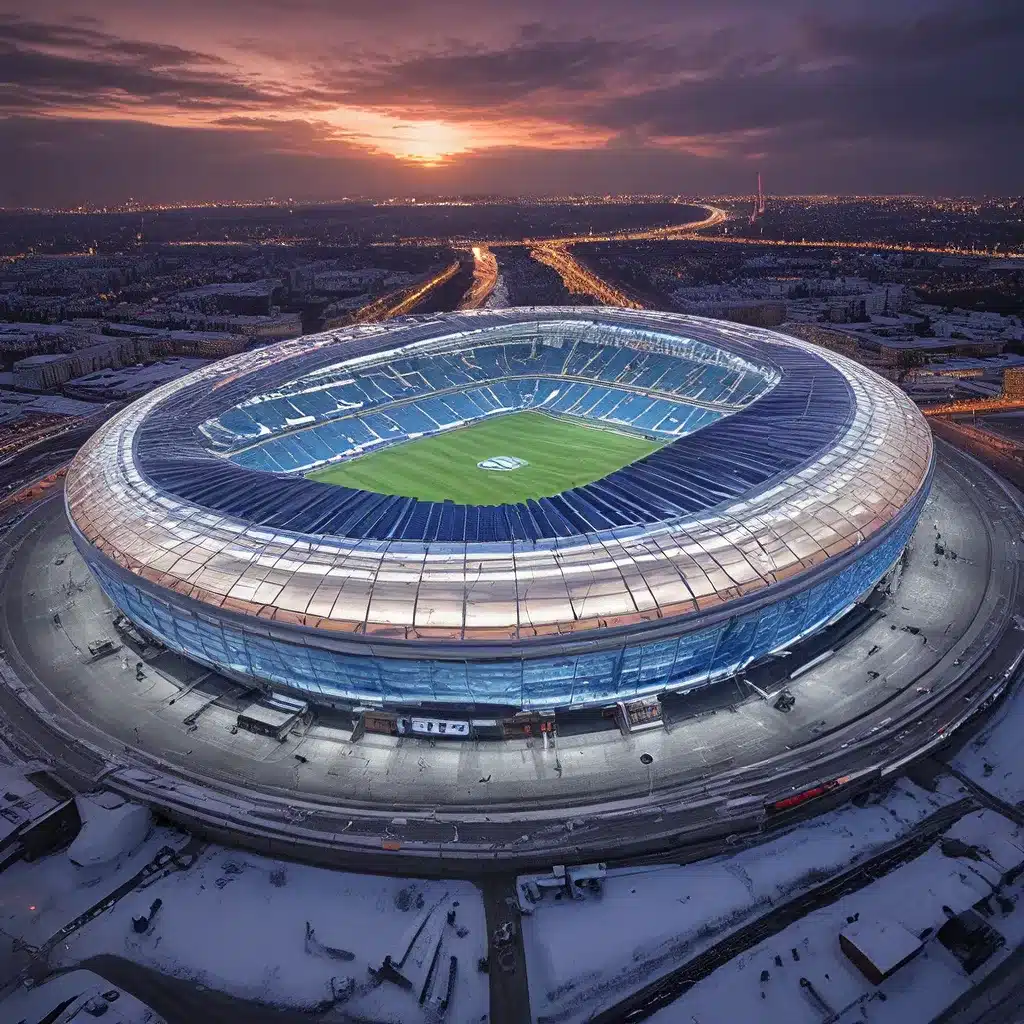
A Architectural Marvel on the Baltic Coast
The Krestovsky Stadium, also known as the Zenit Arena, stands as a striking testament to Russia’s ambition and engineering prowess. Located on the picturesque Krestovsky Island in the heart of St. Petersburg, this futuristic stadium is one of the most technologically advanced and visually stunning venues in the world.
Designed by the renowned Japanese architect Kisho Kurokawa, the Krestovsky Stadium’s sleek, space-age design is a nod to the city’s rich history in space exploration. With its retractable roof and spiky, protruding spikes, the stadium appears to be a modern-day spaceship, seamlessly blending cutting-edge technology with an unmistakably unique aesthetic.
The stadium’s construction was not without its challenges, however. Initially planned to cost around $250 million, the project faced numerous delays and cost overruns, eventually ballooning to over $1 billion – making it one of the most expensive stadiums ever built. Despite the setbacks, the Krestovsky Stadium opened its doors in 2017, just in time to host the 2017 FIFA Confederations Cup, a precursor to the 2018 FIFA World Cup.
A Technological Powerhouse
The Krestovsky Stadium’s most impressive feature is undoubtedly its state-of-the-art technology. Equipped with a retractable roof and a climate control system, the stadium can adapt to a variety of weather conditions, ensuring a comfortable experience for both players and spectators.
The venue’s advanced lighting system is another standout feature, with hundreds of LED lights illuminating the exterior at night, creating a mesmerizing and futuristic display. The 65,000-seat stadium also boasts an expansive, high-definition video screen, one of the largest in Europe, allowing fans to catch every moment of the action in stunning detail.
But the technology at the Krestovsky Stadium goes beyond just the visuals. The facility is also equipped with a hybrid pitch, combining natural grass and artificial turf, ensuring the playing surface remains in top condition throughout the year. This innovative approach helps to minimize the impact of harsh weather conditions and intensive use, making the stadium a true all-weather, all-purpose venue.
A Hub of Sporting Excellence
The Krestovsky Stadium’s cutting-edge design and advanced features have made it a prime destination for some of the world’s most prestigious sporting events. In addition to hosting matches during the 2017 FIFA Confederations Cup, the stadium was a key venue for the 2018 FIFA World Cup, showcasing some of the most thrilling moments of the tournament.
The stadium’s retractable roof and climate control system have also made it a popular choice for other major sporting events, such as the annual St. Petersburg Open tennis tournament. The versatility of the Krestovsky Stadium has allowed it to seamlessly transition from hosting international football matches to world-class tennis competitions, cementing its status as a true multi-purpose arena.
Beyond its role as a sporting venue, the Krestovsky Stadium has also become a hub for cultural events and entertainment. The stadium has played host to numerous concerts, featuring some of the biggest names in music, further solidifying its place as a premier destination in St. Petersburg.
The Legacy of the Krestovsky Stadium
The Krestovsky Stadium’s impact extends far beyond its role as a sports and entertainment venue. The stadium has become a source of pride for the people of St. Petersburg, serving as a symbol of the city’s architectural and technological prowess.
The stadium’s striking design has also inspired a new generation of architects and engineers, who are exploring innovative ways to push the boundaries of stadium design and construction. The Krestovsky Stadium’s success has prompted other cities and countries to invest in similar state-of-the-art facilities, furthering the development of the sports and entertainment infrastructure around the world.
As the 2018 FIFA World Cup and other major events fade into memory, the Krestovsky Stadium continues to serve as a hub for the local community, hosting a variety of events and activities throughout the year. The stadium’s legacy is one of innovation, technological advancement, and a relentless pursuit of excellence – a testament to Russia’s ambition and the power of human ingenuity.
Visiting the Krestovsky Stadium
For those eager to experience the Krestovsky Stadium firsthand, the venue offers a range of opportunities for visitors. Guided tours are available, providing an in-depth look at the stadium’s architecture, technology, and behind-the-scenes operations. Visitors can also explore the stadium’s various amenities, including restaurants, cafes, and fan shops, ensuring a well-rounded and immersive experience.
The stadium’s location on Krestovsky Island also makes it an ideal starting point for exploring the wider St. Petersburg area. Visitors can easily access the city’s iconic landmarks, such as the Hermitage Museum and the St. Petersburg Conservatory, via public transportation or by taking a leisurely stroll along the picturesque Neva River.
Whether you’re a sports enthusiast, an architecture aficionado, or simply a curious traveler, the Krestovsky Stadium is a must-visit destination in St. Petersburg. Its stunning design, cutting-edge technology, and rich history make it a true architectural and engineering marvel, showcasing the best of Russia’s innovative spirit. As you plan your journey to this remarkable landmark, be sure to visit Old Stadium Journey to discover more captivating stories and insights about the world’s most iconic stadiums.

